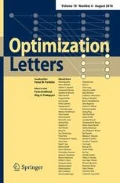Abstract
In this paper we compare two new binary linear formulations to a standard quadratic binary program for the gray pattern problem and solved all three by the Gurobi solver. One formulation performed significantly better and obtained seven optimal solutions that were not proven optimal before. It is interesting that the formulation that performed best is based on significantly more variables and constraints.

References
Adams, W.P., Forrester, R.J.: A simple recipe for concise mixed 0–1 linearizations. Oper. Res. Lett. 33, 55–61 (2005)
Burkard, R.E., Karisch, S.E., Rendl, F.: Qaplib-a quadratic assignment problem library. J. Global Optim. 10, 391–403 (1997)
CPLEX, IBM ILOG (2019). 12.10: User’s Manual for CPLEX. International Business Machines Corporation, Incline Village, NV
Drezner, Z.: Finding a cluster of points and the grey pattern quadratic assignment problem. OR Spectrum 28, 417–436 (2006)
Drezner, Z.: The quadratic assignment problem. In: Laporte, G., Nickel, S., da Gama, F.S. (eds.) Location Science, pp. 345–363. Springer, Cham (2015)
Drezner, Z., Hahn, P.M., Taillard, É.D.: Recent advances for the quadratic assignment problem with special emphasis on instances that are difficult for meta-heuristic methods. Ann. Oper. Res. 139, 65–94 (2005)
Drezner, Z., Misevičius, A., Palubeckis, G.: Exact algorithms for the solution of the grey pattern quadratic assignment problem. Math. Methods Oper. Res. 82, 85–105 (2015)
Gurobi Optimization Incorporate (2018). Gurobi optimizer reference manual. URL http://www.gurobi.com
Hahn, P.M., Zhu, Y.-R., Guignard, M., Hightower, W.L., Saltzman, M.J.: A level-3 reformulation-linearization technique-based bound for the quadratic assignment problem. Inf. J. Comput. 24, 202–209 (2012)
Kang, H.R.: Digital color halftoning. SPIE press (1999)
Kuo, C.-C., Glover, F., Dhir, K.S.: Analyzing and modeling the maximum diversity problem by zero-one programming. Decision Sci. 24, 1171–1185 (1993)
Kuznetsov, Y.V.: Principles of Image Printing Technology. Springer, Cham (2021)
Lau, D.L., Arce, G.R.: Modern Digital Halftoning. CRC Press, Boca Raton (2018)
Loiola, E.M., de Abreu, N.M.M., Boaventura-Netto, P.O., Hahn, P., Querido, T.: A survey for the quadratic assignment problem. Europ. J. Oper. Res. 176, 657–690 (2007)
Martí, R., Gallego, M., Duarte, A., Pardo, E.G.: Heuristics and metaheuristics for the maximum diversity problem. J. Heuristics 19, 591–615 (2013)
Misevicius, A., Palubeckis, G., Drezner, Z.: Hierarchicity-based (self-similar) hybrid genetic algorithm for the grey pattern quadratic assignment problem. Memetic Comput. (2021). https://doi.org/10.1007/s12293-020-00321-6
Palubeckis, G.: Iterated tabu search for the maximum diversity problem. Appl. Math. Comput. 189, 371–383 (2007)
Parreño, F., Álvarez-Valdés, R., Martí, R.: Measuring diversity a review and an empirical analysis. Europ. J. Oper. Res. (2020). https://doi.org/10.1016/j.ejor.2020.07.053
Prokopyev, O.A., Kong, N., Martinez-Torres, D.L.: The equitable dispersion problem. Europ. J. Oper. Res. 197(1), 59–67 (2009)
Taillard, É.D.: Comparison of iterative searches for the quadratic assignment problem. Location Sci. 3, 87–105 (1995)
Ulichney, R.: Digital halftoning. MIT press (1987)
Wong, P.W., Memon, N.D.: Image processing for halftones. IEEE Signal Process. Magaz. 20, 59–70 (2003)
Author information
Authors and Affiliations
Corresponding author
Additional information
Publisher's Note
Springer Nature remains neutral with regard to jurisdictional claims in published maps and institutional affiliations.
Appendix
Appendix
Let \(s^{(p)^*}=(s^*(1), s^*(2),\ldots , s^*(p))\) denote the optimal solution (the optimal configuration of p points in the rectangle of size \(n=n_1\times n_2\); in our case, \(n=64=8\times 8\)). Further, let \(n_1=n_2,~ p'=k^2\times p\) (without the loss of generality), \(k=1, 2,\ldots ,\) and let \(s^{(p')^{**}}=(s^{**}(1), s^{**}(2),\ldots , s^{**}(p'))\) correspond to the configuration of \(p'\) points in the rectangle (square) of size \(k^2\times n=k\times n_1\times k\times n_1\) – such that the rectangle of size \(k^2\times n\) is obtained from the rectangle of size n by replicating this rectangle \(k^2\) times. Then, there exists a solution denoted by \(s^{{(p')}^{***}}\) – such that the following statements hold: \(\frac{p'}{p}\times f(s^{{(p)}^*} )\le f\left( s^{(p')^{***}}\right) \), \(f\left( s^{(p')^{**}}\right) =\omega \times f\left( s^{(p')^{***}}\right) \); here \(\frac{p'}{p}=k^2\), \(\omega (\omega \ge 1)\) is an empirical constant close or equal to 1, and \(f\left( s^{(p)^*}\right) , f\left( s^{(p')^{**}}\right) , f\left( s^{(p')^{***}}\right) \) denote the objective function values corresponding, respectively, to \(s^{(p)^*}, s^{(p')^{**}}, s^{(p')^{***}}.\)
Rights and permissions
About this article
Cite this article
Drezner, Z., Kalczynski, P., Misevičius, A. et al. Finding optimal solutions to several gray pattern instances. Optim Lett 16, 713–722 (2022). https://doi.org/10.1007/s11590-021-01732-1
Received:
Accepted:
Published:
Issue Date:
DOI: https://doi.org/10.1007/s11590-021-01732-1

